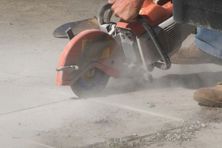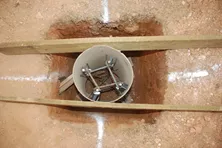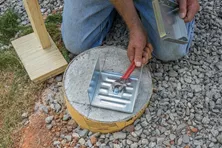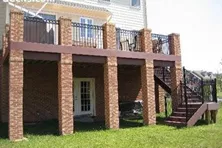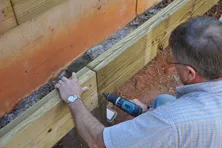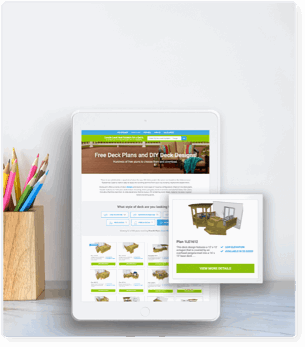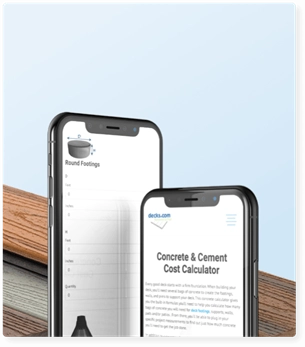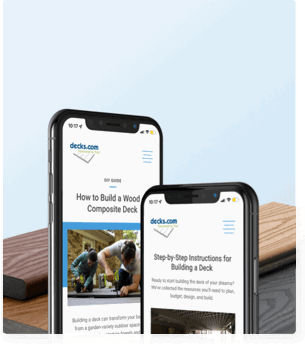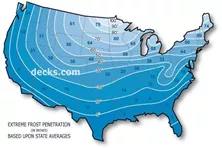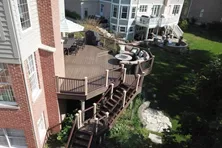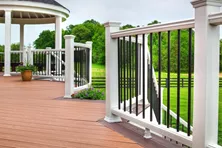Concrete Deck Footing
This footing type uses a concrete pier that extends from the footing base to above grade. There are several variations of this footing type that are commonly used.
Small diameter footings may use a cardboard form tube that is set to the acceptable depth and filled with concrete to produce a monolithic footing.
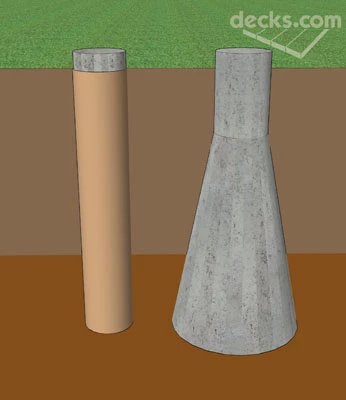
For larger diameter footings, it is more practical to pour a footing base to the appropriate size and depth and extend the footing to the surface with a smaller diameter pier. In order to sufficiently connect the footing to the pier, you will want to use two L-shaped pieces of rebar.
The top of the pier will need to be fitted with a concrete anchor and post base connector in order to accept the deck post. There are different kinds of concrete anchors to choose from that can be installed. Some anchors are set while the concrete is still wet; others are predrilled and then tightened with a wrench to expand into the hardened concrete. Post bases are designed to lock into the concrete anchors and connect to the support posts. The anchor, post base and support post will have to come together in a relatively small area. Using an adjustable post base can give you a little more room to work with.
Footings that use concrete piers offer several advantages over other methods. Once the footings are in place, they will provide permanent visible evidence of the support strength of the structure. Also, this type of footing makes it much easier to replace a post if one ever becomes damaged. You can modify this type of footing by using a rigid plastic base form that is engineered to create a flared base to help prevent frost heaving.
Square footings offer the benefit of maximizing the surface area for soil compression. This variation typically makes more sense where shallow footings are required because hand digging will be required.
Cutting a Concrete Pad
Learn how to use a concrete saw to cut a hole in a patio slab to install a deck footing.
Protecting From Collapse
Learn how to use cardboard sonotubes and hole covers to protect your deck footing holes from caving in and flooding before pouring concrete.
How many footings do I need?
Avoid a wobbly deck! Learn how to calculate the right number of footings to keep your structure safe and solid.
How to Decorate Deck Support Columns
Browse some examples of decorative deck support posts for tall decks.
Beam Span Chart
Learn how to size your deck beam using this easy-to-use span table. Just cross-reference the post spacing and joist length to determine the beam size.
Why is Joist Protection so Important for Your Deck?
If you’ve ever seen a piece of wood left out in the weather for any period of time, you know what happens: decay. Whether through wet rot, insect damage, or mildew, the fibers begin to break down.
More Helpful Resources
Explore Articles by Topic

Footings
Information related to installing frost footings for decks

Framing
Learn structural framing methods

Decking
Learn about wood and composite decking materials

Stairs
An in-depth look at the complex issue of how to build stairs

Railings
How to install guardrails and handrails to meet IRC code

Features
An overview on water drainage, benches, planters and lights

Design
The basics of deck design

Planning
Learn about permits and working with contractors

Porches & Patios
Build a covered deck to enjoy all seasons

Ledger
Proper attachment techniques

Care
Maintain your deck to maintain your investment

Materials
An overview on water drainage, benches, planters and lights
How many footings do I need?
Avoid a wobbly deck! Learn how to calculate the right number of footings to keep your structure safe and solid.
Deck Footing Depth
Find out how deep you need to dig your footings in your area. Look at our U.S. map of extreme frost penetration.
Cutting a Concrete Pad
Learn how to use a concrete saw to cut a hole in a patio slab to install a deck footing.
Why is Joist Protection so Important for Your Deck?
If you’ve ever seen a piece of wood left out in the weather for any period of time, you know what happens: decay. Whether through wet rot, insect damage, or mildew, the fibers begin to break down.
Deck Joist Cantilever & Overhang Rules
Learn what factors determine the maximum joist cantilever overhang that is allowed.
Decks vs. Patios: Cost, Pros, Cons, & Comparisons
Learn what factors affect the costs of decking and patios. Discover all the comparisons factors to help you choose the right space for your home with Decks.com.
Explore Articles by Topic

Footings
Information related to installing frost footings for decks

Framing
Learn structural framing methods

Decking
Learn about wood and composite decking materials

Stairs
An in-depth look at the complex issue of how to build stairs

Railings
How to install guardrails and handrails to meet IRC code

Features
An overview on water drainage, benches, planters and lights

Design
The basics of deck design

Planning
Learn about permits and working with contractors

Porches & Patios
Build a covered deck to enjoy all seasons

Ledger
Proper attachment techniques

Care
Maintain your deck to maintain your investment

Materials
An overview on water drainage, benches, planters and lights




